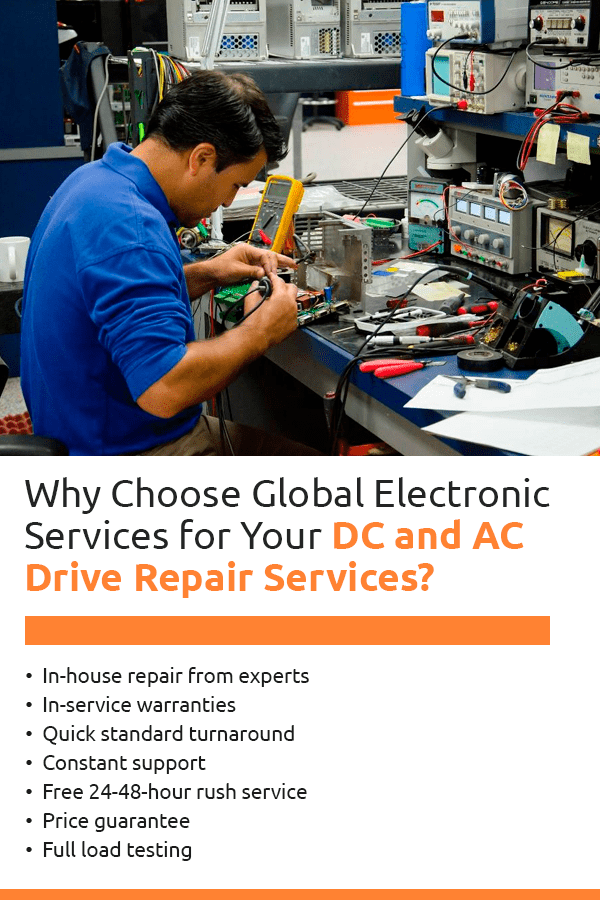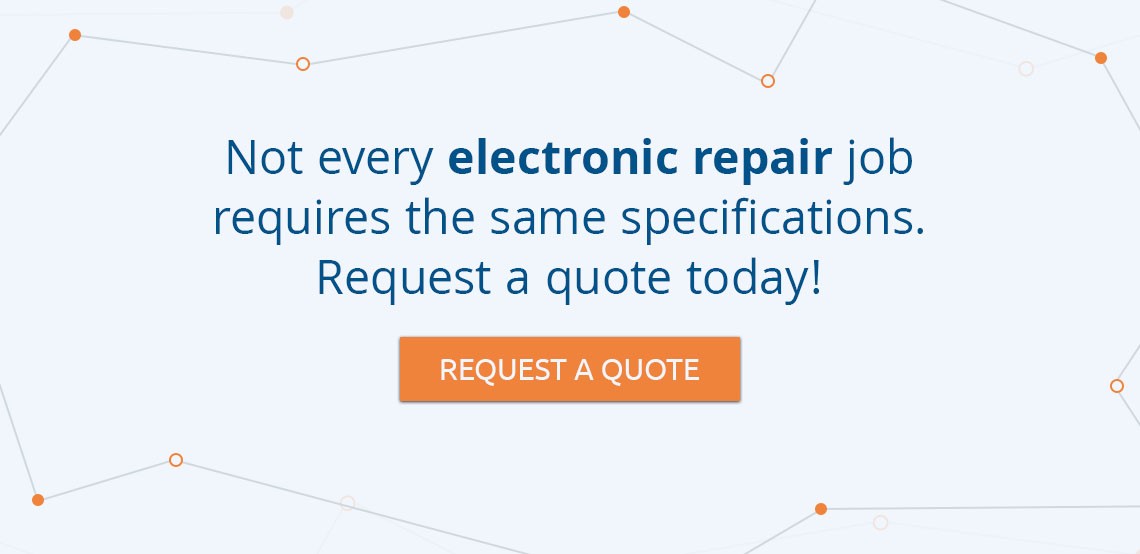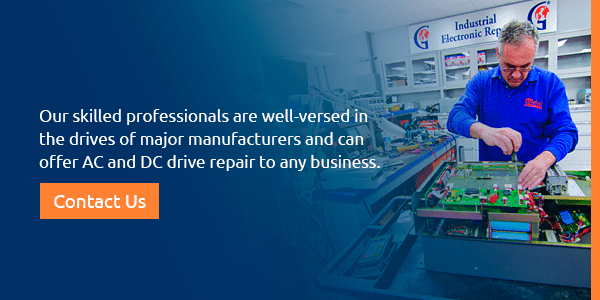AC and DC Drive Repair

Alternating current (AC) and direct current (DC) drives are critical components of many industrial machines. If one goes down, you could face substantial repercussions in terms of productivity and lost revenue, as it powers your essential equipment. To ensure that your electrical AC and DC drives stay working efficiently, you need to make sure you have the right one for the job and that you take care of it accordingly.
Electrical AC and DC drives both offer advantages and disadvantages, and they fit well in specific environments. We’ll take a quick look at how AC and DC drives work and what to look for in an AC and DC drive repair service.
AC and DC Drive Basics
AC and DC drives are two different technologies that control the speed of an electric motor. AC drives are more common, but DC drives have their place in some specific applications. They both convert electrical energy into mechanical energy to drive the motor at varying speeds. You’ll find them powering machines such as conveyor belts, pumps, cranes and ventilators across industrial environments.
An electric drive has an electric motor and a speed control unit. Some other terms for AC and DC drivers include variable-speed drives, variable-frequency drives, adjustable-speed drives and adjustable-frequency drives, though “frequency” only really applies to AC currents.
While they both create a mechanical output from electrical energy, they do so in two different ways.
 How Does an AC Drive Work?
How Does an AC Drive Work?
An AC drive changes the frequency of the electrical supply that it receives and then sends to the motor. Its voltage rises and falls in a sine wave. When this wave is positive, the current goes in one direction, and when the wave is negative, the current moves in the other direction. An AC drive allows you to convert fixed frequencies and voltages to adjustable ones, so you can control or augment various aspects of functioning, such as:
-Starting current -Stopping speed -Protection -Temperature -Pressure
While it might sound a little redundant, an AC drive converts the current from AC to DC and then back to AC again. During the process, the output is significantly increased, so the drive can keep up with or surpass the needs of modern machinery. It also makes it controllable, so you have more say in its effects on the motor.
There are three major components of an AC drive: the rectifier, the DC bus and the inverter.
- Rectifier: The rectifier conducts the initial switch from incoming AC power to DC power. It allows the power to move through when the voltage is positive. If the voltage is negative, a second rectifier can allow it to move through at that phase. A common option is a three-phase power supply with six rectifiers, two for each phase. Some configurations add more for each phase. There are many different types of rectifiers that can use diodes, transistors or silicon controlled rectifiers (SCRs) to control this mechanism.
- DC bus: The DC bus stores the power after its journey through the rectifiers. The capacitors within the bus accept the power to store it and later send it on to the next step, the inverter. They may contain several other components that add inductance, like DC links or chokes. These inductors generate a magnetic field in the direction opposite of the current flow, to better protect circuits from rapid rising and falling currents.
- Inverter unit: After the current passes through the rectifier and the DC bus, it moves onto the inverter. Here, the inverters often use insulated gate bipolar transistors to deliver power to the motor. The inverter can switch power on and off thousands of times a second to control how the power gets delivered. It uses pulse-width modulation (PWM) to simulate the current’s sine wave at the right frequency. This frequency is what determines the motor’s speed and power.
While these components make up the general AC drive, there are a few different types, but they all change a fixed incoming voltage and frequency into variable voltage and frequency outputs. Many of these different types of AC drives will have an additional controller component to accept input and direction from the user, as well as a filter to remove ripples from the DC current. Control schemes can vary significantly and may have a mix of analog and digital inputs and outputs.
How Does a DC Drive Work?
DC drives share a similar basic principle to AC drives, but they convert the AC current to a DC current to power a DC motor. There is no return to the original AC current, so its circuitry may look similar to that of an AC drive, but with the rectifier and output in one stage. Most DC drives use a method called a thyristor bridge, often with similar SCRs to the ones in an AC drive.
SCRs to make a half cycle of DC output from a single-phase AC input. Some use full-bridge supplies with six SCRs and a three-phase AC input. The rectifier uses diodes and thyristors to control the speed.
DC motors see speeds that are directly proportional to the voltage that is applied to the drive’s armature. This design gives DC motors a “no-load” trait. If they receive a fixed voltage and a torque load that gradually increases, the speed will drop. The DC drive’s controls compensate for this change. The motor torque is separate and is typically controlled by the current that reaches the armature.
Instead of having a separate rectifier stage, a DC drive has a regulator to control various aspects. It accepts the incoming AC power and converts it to DC power like the rectifier would in the AC model. Then, it adjusts the output of the DC power in amperage and voltage to regulate performance. It may alter in response to certain feedback signals it gets from the motor and make appropriate changes to torque and speed.
Many DC drives use tachometers to provide feedback from the motor. These devices are similar to a permanent magnet attached to the main motor shaft. High-speed motors create more voltage in the tachometer, and the drive looks at this voltage to ensure it runs at the correct speed. In newer models, aspects like current, speed and voltage can be configured. They may also offer protection against things like overcurrents, high temperatures and phase and field loss.

AC and DC Drive Differences
AC and DC drives offer robust performance and minimal maintenance for various applications. AC drives are more common, simply because of their wide-reaching advantages for most machinery, but DC drives offer high torque at startup and work well in certain uses.
AC drives offer:
- Energy savings and a lower operating cost.
- Simple installation with a smaller, more off-the-shelf design.
- Reduced mechanical and thermal stress on components during startup.
- Reliability.
- Better handling of changes in speed.
- Lots of programmable parameters and fail-safes.
- More advanced features, like network controls and monitoring.
One of the primary benefits of an AC drive is the energy savings that come with it. A PWM AC drive works well in applications with variable torque, and even small decreases in equipment use offer substantial reductions in energy use. The United States Department of Energy states that reducing a rotating piece of equipment’s speed by 20% can yield reduced power requirements of about 50%.
AC drives help by adjusting equipment power consumption during off-peak usage. Most equipment is designed for a peak load, but during the hours where it is running at a lower capacity, it only needs a very small amount of that flow, hence the energy savings. AC drives use several mechanisms, like throttling valves and dampeners, to control the capacity and of the flow for maximum efficiency. With these components, your company can see significant energy savings from an adjustable speed drive, especially if your machinery typically runs at partial loads.
While an AC drive is more complex than a DC drive, it is much simpler than it used to be. Manufacturers have made a point to increase ease of use and simplicity. This easy installation helps it to match one of the primary benefits of DC drives, which is their simple, straightforward design. Despite the more complicated design of the AC drive, it still has lower maintenance requirements, making it good for hard-to-access locations.
With a DC drive, you get:
- Better handling of changes in speed from voltage changes.
- Low cost for medium- and high-horsepower applications.
- Wide range of speed.
- Easy operation.
DC drives excel in some niche environments, where you may encounter an array of changing loads. High speeds and high-torque applications are also well-suited to DC drives due to their powerful startup and low costs in high-horsepower applications. Regenerative power is another area where DC drives excel.
A DC drive may struggle in harsh environments, so it should only be used in clean and dry places. It may be easier to find specialized enclosures for AC drives since they’re more common. In wet or corrosive environments, this kind of housing is critical to keep the drive safe, regardless of its design style.
Common Uses for AC and DC Drives
Due to their differing designs, these drives are often better suited for specific tasks.
As mentioned, DC drives are well-suited to some specific types of machine use, like high-torque requirements, while AC drives are often used where the motor runs at a constant speed.
One of the most popular uses for AC drives are heating, ventilation and air conditioning (HVAC) applications, where items like fans, compressors and pumps are common. If an AC drive, as opposed to mechanisms like valves and dampers, controls a fan or pump, it can save energy by only supplying what’s necessary, instead of reducing energy after it’s supplied. In addition to saving energy and reducing stress on components, it can also lower the noise levels.
While AC drives are starting to match the advantages of DC drives, DC is still the drive of choice for robust machinery such as cranes, hoists, crushers and elevators, among many others. It is reliable and cost-effective, with the necessary outputs to run those powerful pieces of equipment.

Why Choose Global Electronic Services for Your DC and AC Drive Repair Services?
Whether your machinery runs on DC or AC drives, you’ll probably have to service or repair them at some point. When that time comes, you need a trusted, reliable partner to help you conduct service. Here at Global Electronic Services, we offer just that with the help of our staff of AC and DC drive repair specialists. They know these electrical drives inside and out and can help diagnose and solve a wide array of problems to get you back up and running.
We’ve been helping users of AC and DC drives keep things moving for years, in a wide variety of applications. Manufacturing and distribution operations of all types have turned to Global Electronic Services to fix their electrical drives.
When you partner with us, you get:
- In-house repair from experts: We keep knowledgeable and well-trained technicians on staff to handle anything you can throw at us.
- In-service warranties: If we supplied your electrical AC or DC drive, we offer an 18-month warranty for it. We can take care of the work and fulfill manufacturer warranties through that time.
- Quick standard turnaround: Every minute of downtime is another minute of lost productivity. We aim to reduce downtime for our clients in several ways. One of those ways is to offer fast response and service. We typically get your problem fixed within five days or less, depending on the issue.
- Constant support: Industrial repairs don’t wait for a typical business schedule, and neither do we. We have experts on call and ready to help 24/7.
- Free 24-48-hour rush service: We know how important it is to get up and running as fast as possible, so we offer free rush service to get your product back within two days.
- Price guarantee: If you find one of our products offered somewhere else for less, we’ll beat it by 10%, so you know you’re getting the best deal with us.
- Full load testing: “Normal” conditions aren’t representative of performance under peak conditions. We’ll test your product under a full load before sending it back.
We know how important drives are to most operations. You probably can’t go more than a few days without them without seeing significant losses in productivity and revenue. One of our main priorities is to reduce the downtime your company experiences. Our quick turnaround times, after-hours response and exceptional communication practices allow us to do so. We’ll get you back on the job as quickly as possible with a machine that’s running smoothly.
Request a Quote Today
Our skilled professionals are well-versed in the drives of major manufacturers and can offer AC and DC drive repair to any business. Shipping is fast and allows us to offer repair services worldwide. We offer free evaluations, too, and you won’t pay if we don’t find a problem.
To learn more about repairing an AC or DC drive with Global Electronic Services, request a quote today so we can get your machinery back to work.
Additional Resources:


